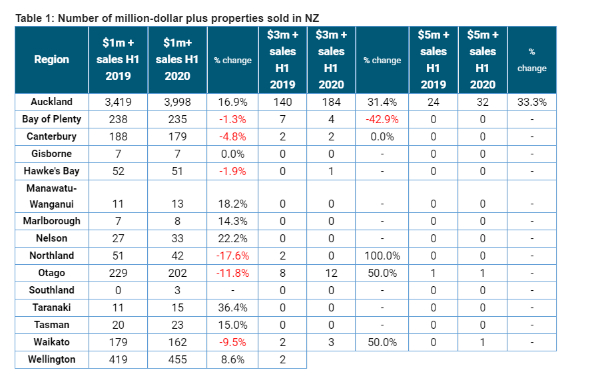Million Dollar Plus Property Sales Increase 11.7% Nationally, Says REINZ
The number of properties sold around the country for one million dollars or more during the first half (H1) of 2020 increased by 11.7% compared to H1 2019, with 5,426 million-dollar plus properties sold (up from 4,858 in H1 2019) according to the Real Estate Institute of New Zealand’s (REINZ) Million Dollar Price Report.

Looking at New Zealand excluding Auckland, the number of million-dollar plus properties sold decreased slightly by -0.8% (1,428 down from 1,439 –11 fewer properties).

In Auckland the number of million-dollar plus properties sold during the first half of 2020 increased by 16.9% when compared to the previous year (3,998 up from 3,419) - the largest annual percentage increase for the Auckland region since H1 2016.
Bindi Norwell, Chief Executive at REINZ says: “Auckland appears to be leading the regions again with its percentage of million dollar plus sales, increasing 16.9% year-on-year. Nationally, we are seeing the same demand for properties, pushing up the number of million-dollar plus sales. The shortage of housing stock appears to be a continued influence on house prices.
“The top end of the market seems to have also benefitted from the flow on effect, seeing a 30.7% increase in the $3 million plus category and a 38.5% increase in the $5 million plus category nationally,” points out Norwell.
“Regardless of the difficulties faced over the last few months with COVID-19 and the lockdown period, the first half of 2020 still outperformed the first half of 2019 when it comes to $1 million plus sales,” concludes Norwell.
Regional breakdown
The region with the biggest percentage increase in number of properties sold for $1 million dollars or more was Taranaki, with a 36.4% increase from H1 2019 (15 properties up from 11). However, these percentage increases do appear more inflated due to the small sample sizes.
8 out of 16 regions saw year-on-year increases in the number of properties sold for $1 million or more in H1 2020. Nelson increased 22.2% year-on-year, reaching a new record level of $1 million plus sales (33 properties up from 27 in H1 2019). Four additional regions also reached record equal numbers of million dollar plus sales. West Coast remains the only region to have not sold a residential property for $1 million plus.
Regions reaching record equal number of $1 million plus sales in H1 2020 were:
- Gisborne: 7 properties sold for $1 million plus (record first set in H1 2019)
- Manawatu/Wanganui: 13 properties sold for $1 million plus (record first set in H2 2018)
- Southland: 3 properties sold for $1 million plus (record first set in H2 2019)
- Tasman: 23 properties sold for $1 million plus (record first set in H2 2018).
Regions with the strongest percentage increases in the number of $1 million plus sales between H1 2019 and H1 2020, in addition to Taranaki, were:
- Nelson: +22.2% (from 27 to 33 properties – an additional 6 properties)
- Manawatu/Wanganui: +18.2% (from 11 to 13 properties – an additional 2 properties)
- Auckland: +16.9% (from 3,419 to 3,998 properties – an additional 579 properties)
When looking at the number of properties sold for $3 million or more in H1 2020, Wellington saw the largest percentage increase, growing from 2 properties in H1 2019, to 7 properties in H1 2020 (a 250% increase year-on-year).
Other regions that saw an increase in the $3 million plus category were:
- Otago: +50.0% (from 8 to 12 properties – an additional 4 properties)
- Waikato: +50.0% (from 2 to 3 properties – an additional 1 property)
- Auckland: +31.4% (from 140 to 184 properties – an additional 44 properties).
New Zealand and Auckland increased in the number of sales for the $1 million plus category, the $3 million plus category and the $5 million plus category in H1 2020 when compared to the same period in 2019 - indicating the ongoing strength of the property market throughout the country.
Bindi Norwell says: “There are a number of potential factors that weigh into the rise of million dollar plus properties sold across the country, including an ongoing shortage of supply combined with an increased level of demand (particularly over the last few months, with Kiwis returning home); improving consumer confidence (as indicated in the REINZ Monthly Confidence Report); low interest rates and LVR opportunities for first home buyers; and continued investment in the regions. These factors, regardless of the price bracket they may directly impact, lift the overall market.
“While we are currently seeing positive movements, we are conscious of the fact that mortgage holidays and wage subsidies are coming to an end shortly, and we could possibly see demand ease over the coming months,” concludes Norwell.


 Bill Bennett: Download Weekly - Review Of 2024
Bill Bennett: Download Weekly - Review Of 2024 Bill Bennett: One NZ scores worldwide first as Starlink direct-to-mobile launches
Bill Bennett: One NZ scores worldwide first as Starlink direct-to-mobile launches Hugh Grant: How To Reduce Network Bottlenecks
Hugh Grant: How To Reduce Network Bottlenecks Dominion Road Business Association: Auckland Transport's 'Bus To The Mall' Campaign: A Misuse Of Public Funds And A Blow To Local Businesses
Dominion Road Business Association: Auckland Transport's 'Bus To The Mall' Campaign: A Misuse Of Public Funds And A Blow To Local Businesses Parrot Analytics: A Very Parrot Analytics Christmas, 2024 Edition
Parrot Analytics: A Very Parrot Analytics Christmas, 2024 Edition Financial Markets Authority: Individual Pleads Guilty To Insider Trading Charges
Financial Markets Authority: Individual Pleads Guilty To Insider Trading Charges



